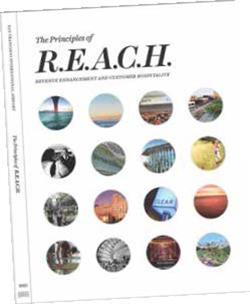San Francisco Int'l Installs Wayfinding Towers & Custom Self-Service Check-in Units

As part of an ongoing effort to improve the passenger experience, San Francisco International Airport (SFO) recently debuted more than 80 new common-use self-service units (CUSS) in its International Terminal.
Rick Thall, project manager at SFO, explains that the form and function of the custom units were heavily influenced by the airport's Revenue Enhancement And Customer Hospitality (REACH) initiative, a program designed in part to guide consultants in shaping SFO's long-term passenger experience (see sidebar on for more details). Gensler, the airport's long-time design partner, helped develop the program.
One of REACH's underlying goals is to reduce stress for passengers. The new CUSS stations help travelers save time and feel at ease when navigating through check-in, ticketing and baggage check processes, explains Thomas Horton, senior associate and design director with Gensler's brand design group.
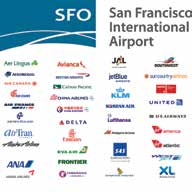 facts&figures facts&figuresProject: Common-Use Self-Service Desks; Wayfinding Towers Location: San Francisco Int'l Airport Cost: $3.8 million (includes planning; design; infrastructure improvements; fabrication & installation) Design Consultant: Gensler CUSS Manufacturer: IER Common-use Software: ARINC Timeline: Product research began in 2013; prototype was presented for airport response in 2015; units installed in early 2016 Key Benefits: Expedite check-in, ticketing & bag check processes; reduce stress for passengers |
When the previous standalone CUSS units in the International Terminal were nearing the end of their five- to seven-year lifespan in 2013, airport personnel began looking for replacements. John Martin, SFO's director at the time, guided the process by pushing the project team to consider new options and question prevailing design assumptions, notes Thall.
Although the airport's previous kiosks (made by IER) provided a simple, straightforward check-in process for passengers, officials were unhappy with their "cold" look, Horton recalls.
After research efforts failed to find an acceptable alternative that provided the right user experience, the airport partnered with Gensler and IER to design and construct an entirely new custom CUSS unit. The end result provides passengers with a high level of customer service, while also fitting in with the aesthetics of the terminal and the airport as a whole, says Horton.
"We wanted to create a design that was complimentary to the International Terminal environment, but also didn't look like a piece of machinery," he explains. "It was rethinking how this technology could fit into an architectural environment."
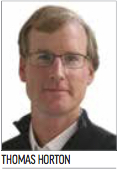 That meant designing a furniture-like unit that resembled a hotel counter more than an automated teller machine, notes Horton. Taking cues from the architecture of the terminal, designers incorporated glass and metal tones into the new CUSS desks. In addition, they used Corian countertops and wood to soften the look and give the units what Horton calls a "hospitality vibe."
That meant designing a furniture-like unit that resembled a hotel counter more than an automated teller machine, notes Horton. Taking cues from the architecture of the terminal, designers incorporated glass and metal tones into the new CUSS desks. In addition, they used Corian countertops and wood to soften the look and give the units what Horton calls a "hospitality vibe."
Every detail was carefully analyzed, says Thall-from the overall dimensions and number of check-in stations to the colors and materials.
In the end, designers made the units 46 inches wide and 140 inches long, with six check-in stations-three on each side. An edge-lit piece of acrylic glass running down the center serves as a privacy screen between the two sides and also helps attract the attention of passengers. "It acts almost as a beacon to guide or draw customers toward the check-in environment," Horton notes.
Designers also considered what travelers typically carry with them and what they do when checking in. The large Corian countertops are not only attractive, but also extremely functional, Thall notes. Passengers have space to rest a beverage and briefcase, backpack or purse and organize their belongings, without encroaching on the people next to them.
All the technology is located under the counter. "So it's there when you need it, but it's not something that's staring you in the face," Horton explains.
Creating a streamlined and simple design aesthetic fit with the airport's REACH goal of improving the passenger experience, Thall notes. Because the self-service check-in process is relatively new-especially the self-bag tag aspect-it was critical to keep the look and feel of the CUSS units as intuitive as possible. "It's important that it's clearly understood what these units are for when [frequent and first-time travelers] see them," he says.
"Passengers are used to walking up to a gate agent or check-in counter and having everything taken and done for them," Horton says, noting that some passengers are intimidated by the prospect of checking themselves in for flights. "The design of the unit was really intended to be welcoming and make them feel at ease, and diffuse that sense of foreboding that they're going to have when confronted with this new process that they're unfamiliar with," he explains.
The way travelers interface with the self-service units also guided practical design elements. For example, passengers tagging their own bags are left with strips of paper from the self-adhesive labels. Originally, the CUSS units included built-in trash bins; but that created logistical challenges for janitorial staff to empty them, because the units need to remain secure. The final design includes trash bins next to the check-in stations.
"This was examining how people behave within this check-in environment and learning to create a unit that responded to that behavior," Horton says.
Location, Location, Location
The layout of the new CUSS units was designed to address the architectural makeup of the ticketing/check-in area and the way passengers arrive and interact in that space. "It's a very big space with large queuing areas," Horton notes.
As such, planners used circulation analysis to determine the best setup for the new self-service desks. Layout was a particular challenge because passengers enter the ticketing hall from four different directions. "If you only distribute the units in one particular part, then a good percentage of the population is going to either miss them or have a long walk to find them," Horton explains.
Previously, passengers tended to stumble upon the CUSS kiosks rather than be directed toward them, he notes. To remedy that situation, designers established identifiable check-in zones by placing long banks of the new CUSS units down the middle of the most prominent passenger thoroughfares. They also created separate "islands" of stations around the perimeter-particularly at the entrance from the Bay Area Rapid Transit (BART) station.
Concentrating CUSS stations in well-defined locations helps passengers find them and also makes it easier for airline staff to assist customers through the on-screen process, comments Horton.
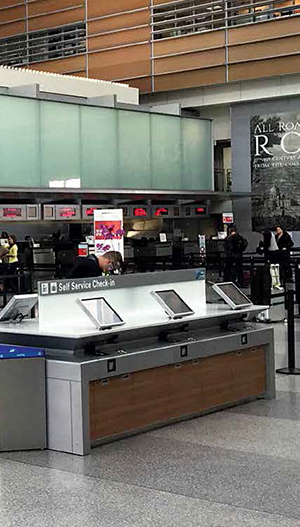
Previously, self-service kiosks blended into the lobby environment due to their small size and gunmetal grey finish. By creating a unit with more mass that compliments the surrounding aesthetics, passengers are now attracted to the check-in stations, says Horton.
Infrastructure planning and upgrades were another key piece of the project. When CUSS technology was first introduced in the International Terminal, individual kiosks were placed somewhat haphazardly, Thall relates. The layout of individual units was based on wireless connections or the location of power and data in the floor. "We wanted to figure out how we could be deliberate to put these in the locations where we thought they would be best located and make sure that we had a reliable data and power connection," Thall says.
Design Challenges
Creating the custom CUSS desks was a tall order. Boarding pass and baggage tag printers, along with scanners for identification documents and a computer interface, all needed to fit inside. The equipment that IER ultimately manufactured is sophisticated and performs many important functions in a very compact unit, relates Horton.
The stations also had to comply with accessibility requirements per the Americans With Disabilities Act, be secure (but easily serviceable by maintenance staff) and meet the aesthetic and customer service expectations of SFO officials.
The design and conceptual phase was a "major effort," recalls Montee Fiely, director of North American sales for IER. Despite their sleek design, the new CUSS stations had to include the same operating components as their less-attractive kiosk predecessors. "There's only a small space where you can place the motherboard, printers and all the components," Fiely explains. "You have to keep them in the same assembly formation whether they are inside of a kiosk or not."
 Placing a countertop for passengers near expensive technology created additional challenges. To prevent coffee or other liquid spills from running down into the unit, designers sealed the opening along the edge-lit acrylic and positioned the counter so it overhangs the technology below.
Placing a countertop for passengers near expensive technology created additional challenges. To prevent coffee or other liquid spills from running down into the unit, designers sealed the opening along the edge-lit acrylic and positioned the counter so it overhangs the technology below.
Shipping and installation were carefully orchestrated as well, Horton adds. At roughly 1,500 pounds each, the CUSS desks are fairly substantial pieces of furniture, he quips. Units were manufactured in Atlanta, shipped in modules and assembled on the terminal floor during non-passenger hours.
Learning From Prototypes
The team built "crude but effective" full-size prototypes and placed them in the terminal in January 2015 to provide airport officials with a preview of what was to come.
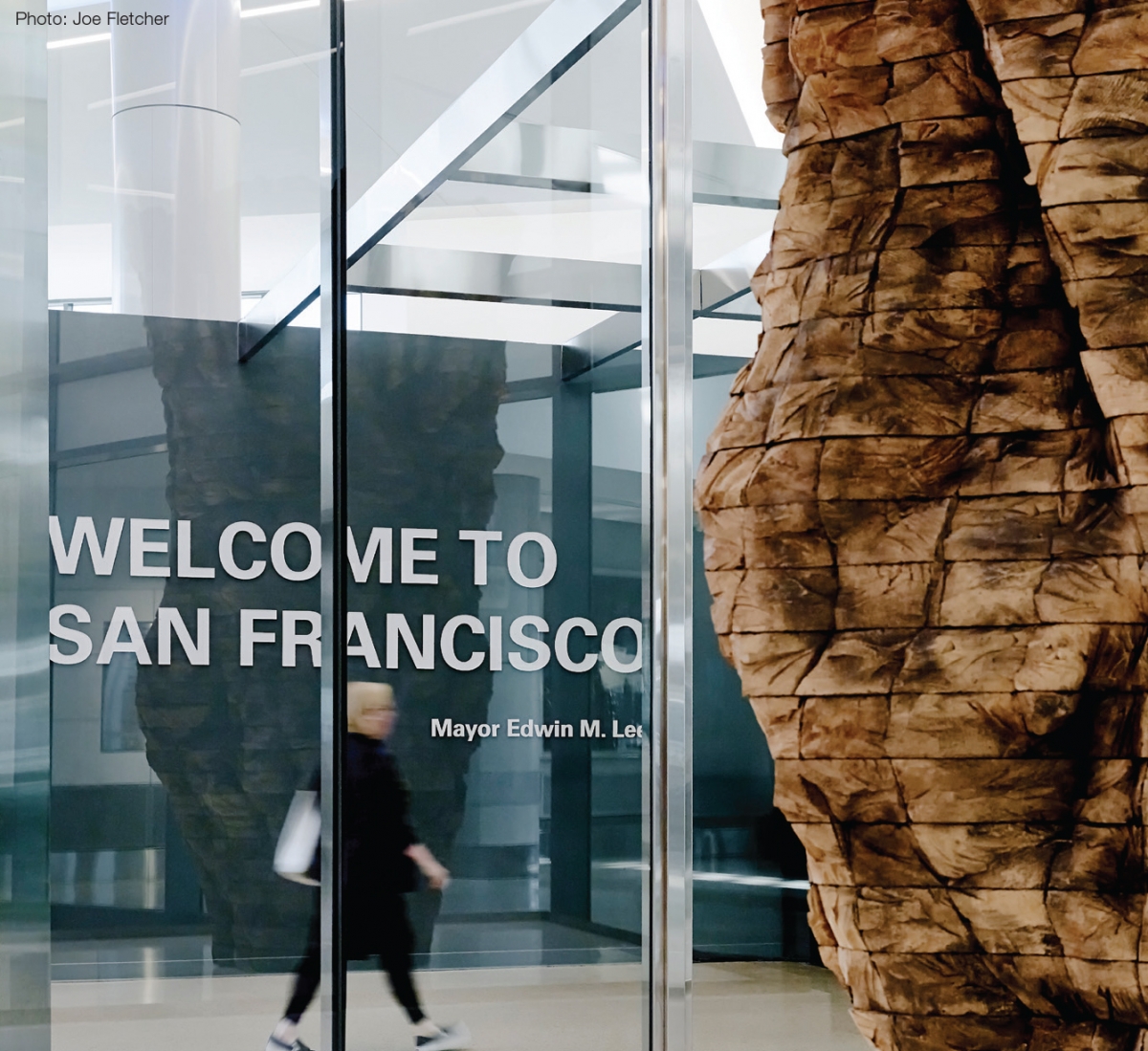
"It gave them the opportunity to kick the tires before committing to the design," Horton explains. "It was a very successful way of helping SFO management feel comfortable about how these units were going to feel in the space, that the scale was correct as you walk up to it, that the height for all equipment was adequate."
Because the design of the new CUSS unit was unique, there were functional elements such as cooling units and a rail system to slide the technology components out for maintenance that could not be anticipated without using a prototype, Horton says.
After the mock-up stage, IER constructed a fully functional unit, which SFO officials and the design team tested before placing it on the floor for passengers to interact with.
The prototyping strategy was "really advantageous," Horton relates. "It gave us a considerable amount of user data that informed the final units."
Wayfinding Towers
During the CUSS project, SFO also installed new wayfinding towers along the main pedestrian path of the International Terminal-addressing yet another touch point of the REACH program, notes Horton.
"People are, in most cases, very time sensitive when they travel through airports," he explains. "Effective wayfinding goes a long way toward both reducing their stress and bringing about a higher sense of customer satisfaction."
The new towers stand nearly 12 feet tall, and the content displayed on 46-inch LED monitors that cover all four sides can be changed in real-time to reflect the carriers operating at that check-in area. 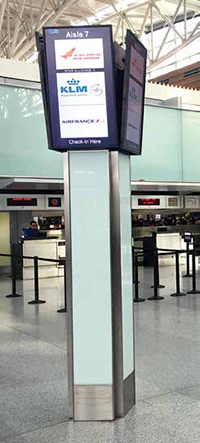 Because of their size and location, the towers provide long-distance assistance for passengers and guide them to specific airlines once they get closer, Horton relates.
Because of their size and location, the towers provide long-distance assistance for passengers and guide them to specific airlines once they get closer, Horton relates.
Like the CUSS units, the new wayfinding towers also went through several design iterations. Thall describes initial executions as much larger and clunkier than the final design, which includes materials that coordinate with the rest of the terminal.
"All of these things work with the aesthetic of the building and feel like they could have been there from the original construction," he adds. "They look modern, yet fit in with the aesthetic of this building that's now 15+ years old."
Although the new wayfinding towers are able to display marketing information, Horton notes that SFO is proceeding cautiously to maintain a careful balance. "We've learned from various wayfinding exercises that visual clutter and changing some of those dynamic signs can potentially add to increased confusion with passengers," he explains.
Industry-Changing Results
From the airport's perspective, the CUSS project was a good opportunity to challenge the industry. "It was a unique process being able to work with a manufacturer and designer to collaborate and create something that hopefully pushed the envelope a little bit more of what amenities in an airport can be," says Thall.
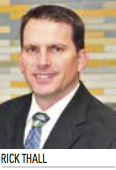 According to Horton, the most important lesson his team learned was that projects that involve dramatic changes do not develop in a linear process. "We had to rethink some of our assumptions-go back to the drawing board a couple of times, and a lot of it was driven by the prototyping process," he reflects.
According to Horton, the most important lesson his team learned was that projects that involve dramatic changes do not develop in a linear process. "We had to rethink some of our assumptions-go back to the drawing board a couple of times, and a lot of it was driven by the prototyping process," he reflects.
After watching the custom CUSS units operate for about one year, Thall reports that the new stations facilitate faster, more efficient check-in and provide flexibility for how the airport uses its terminal space. Currently, SFO has 12 CUSS units in each of the seven aisles in its International Terminal, and team members expect to procure more within the next year to 18 months.
REACHing for Higher Service & Revenue LevelsThe new wayfinding towers and self-service check-in stations at San Francisco International (SFO) are just two of many projects influenced by the airport's Revenue Enhancement And Customer Hospitality (REACH) initiative. The roots of the program date back to the redevelopment of Terminal 2, completed in 2011. SFO Project Manager Rick Thall explains that after the huge project, officials wanted to document the design qualities that enhance the passenger experience and create a program that would provide guidance and standards for future projects. To develop the program, SFO enlisted the help of its long-time design partner, Gensler. REACH highlights 10 specific focus points: The list, which Thall describes as the "true values of SFO," was developed to guide improvement efforts throughout the airport. "We take an opportunity with each project to evaluate the different values of the program and look to optimize the passenger experience," notes Thall. Toward that end, the REACH guidebook addresses the passenger experience from arrival at the airport to boarding the plane. To enhance effectiveness, it subdivides passengers into five categories-leisure, assisted, business, unique and family-and addresses values and expectations specific to each type of passenger. Further, it identifies opportunities to improve the experience for category of passengers during crucial "journey moments" at various locations: • approaching the airport "REACH is a dynamic program that really represents the personification of some of the values in the journey moments along the way for passengers," Thall explains. [The CUSS project] is just one example [where] REACH can help with improving the guest experience." |
FREE Whitepaper
PAVIX: Proven Winner for All Airport Concrete Infrastructure
International Chem-Crete Corporation (ICC) manufactures and sells PAVIX, a unique line of crystalline waterproofing products that penetrate into the surface of cured concrete to fill and seal pores and capillary voids, creating a long lasting protective zone within the concrete substrate.
Once concrete is treated, water is prevented from penetrating through this protective zone and causing associated damage, such as freeze-thaw cracking, reinforcing steel corrosion, chloride ion penetration, and ASR related cracking.
This white paper discusses how the PAVIX CCC100 technology works and its applications.
